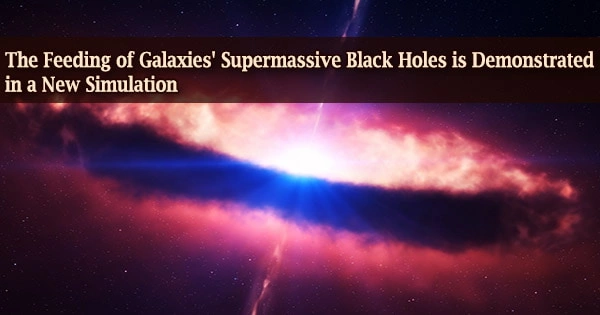According to a new high-powered simulation, galaxies’ spiral arms are responsible for sweeping up gas to fuel their center supermassive black holes.
The simulation, which began at Northwestern University, is the first to demonstrate how gas moves across the universe all the way down to the heart of a supermassive black hole in amazing detail.
While prior simulations have represented black hole growth, this is the first computer simulation powerful enough to account for all of the dynamics and processes that influence supermassive black hole evolution.
The simulation also sheds light on the mystery nature of quasars, which are extremely bright, rapidly expanding black holes. Quasars are some of the brightest objects in the cosmos, often outshining entire galaxies.
“The light we observe from distant quasars is powered as gas falls into supermassive black holes and gets heated up in the process,” said Northwestern’s Claude-André Faucher-Giguère, one of the study’s senior authors.
“Our simulations show that galaxy structures, such as spiral arms, use gravitational forces to ‘put the brakes on’ gas that would otherwise orbit galaxy centers forever. This breaking mechanism enables the gas to instead fall into black holes and the gravitational brakes, or torques, are strong enough to explain the quasars that we observe.”
The reason supermassive black holes are so difficult to explain is that forming them requires cramming a huge amount of matter into a tiny space. How does the universe manage to do that? Until now, theorists developed explanations relying on patching together different ideas for how matter in galaxies gets crammed into the innermost one-millionth of a galaxy’s size.
Faucher-Giguère
The research was published today (August 17, 2021) in the Astrophysical Journal.
Faucher-Giguèreis an associate professor of physics and astronomy at Northwestern’s Weinberg College of Arts and Sciencesand a member of the Center for Interdisciplinary Exploration and Research in Astrophysics(CIERA).
The paper’s first author is Daniel Anglés-Alcázar, an assistant professor at the University of Connecticut and former CIERA scholar in Faucher group. Giguère’s Supermassive black holes can devour 10 times the mass of the sun in a year, equating to the mass of millions or even billions of suns.
While some supermassive black holes have an endless supply of food, others sit dormant for millions of years before reawakening unexpectedly with a gas inflow. The specifics of how gas travels across the universe to feed supermassive black holes have long been a mystery.
To solve this puzzle, the researchers created a new simulation that combines many of the key physical processes into one model, such as the expansion of the universe and the galactic environment on enormous scales, gravitational gas hydrodynamics, and feedback from huge stars.
“Powerful events such as supernovae inject a lot of energy into the surrounding medium, and this influences how the galaxy evolves,” Anglés-Alcázar said. “So we need to incorporate all of these details and physical processes to capture an accurate picture.”
The new method, which builds on prior work from the FIRE (“Feedback In Realistic Environments”) project, dramatically improves model resolution and enables for more than 1,000 times greater detail than previously feasible when the following gas as it flows throughout the galaxy.
“Other models can tell you a lot of details about what’s happening very close to the black hole, but they don’t contain information about what the rest of the galaxy is doing or even less about what the environment around the galaxy is doing,” Anglés-Alcázar said. “It turns out, it is very important to connect all these processes at the same time.”
“The very existence of supermassive black holes is quite amazing, yet there is no consensus on how they formed,” Faucher-Giguère said.
“The reason supermassive black holes are so difficult to explain is that forming them requires cramming a huge amount of matter into a tiny space. How does the universe manage to do that? Until now, theorists developed explanations relying on patching together different ideas for how matter in galaxies gets crammed into the innermost one-millionth of a galaxy’s size.”
Researchers can now model how this occurs thanks to the new simulations. The new simulation, for example, will aid researchers in deciphering the origins of the supermassive black hole at the heart of our Milky Way galaxy, as well as the supermassive black hole at the center of the Messier 87 galaxy, which was famously caught by the Event Horizon Telescope in 2019.
The researchers then plan to look at vast statistical populations of galaxies and their center black holes to learn more about how black holes emerge and grow under different situations.





